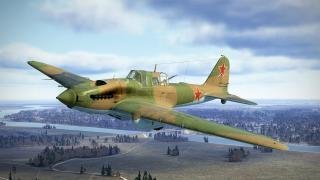Dev blog #153
24.03.2017

While we were preparing this Dev Diary, sad news arrived - Soviet test pilot Stepan Anastasovich Mikoyan who fought in the battle of Stalingrad passed away in Moscow at age 95.
It is very sad that such a veteran is no longer with us. We are grateful for his defense of the Motherland and his enormous contribution for aviation development.We are proud that we knew him and he helped us in the development.
While our VR implementation is going according to the plan, we have good news from the engineering department and its head AnPetrovich for you. As we mentioned earlier, we decided to spend a huge chunk of time on flight model corrections and improvements on a very important and big task - improving the aircraft reaction to rudder inputs. This is a very complex task since FMs in our project has many physical interconnections which weren't supposed to be altered - when you change any one parameter it affects many things you never planned to change or sometimes even expected to change. The challenge for us was the fact that we attempted to solve this issue several times, but we finally found the real physical cause for it and a possible way to fix it only in the end of the last year. Since the solution for it requires fundamental changes to fuselage aerodynamics calculations, it means that we need to correct the aerodynamics of all the aircraft that exist in the game to this day. Therefore, a total revision of all stability and handling parameters of all aircraft in the game is happening right now. Of course, such significant and fundamental changes affect not only the way a rudder affects an aircraft, but many other things. Base flight characteristics like speed, climb rate, turn time, etc. won't change, but many others will. Here's the short list of improvements we all will benefit from when this task is completed:
1. Flight stick movements along the roll axis required to compensate for the roll drift during slide reduced significantly;
2. While a strong rudder input is given, aircraft will tend to 'plow in' while making a barrel roll;
3. Flat turns are now possible almost at any speeds, including near stall situations (ailerons input is enough to keep the aircraft level and the flat turn itself becomes more effective);
4. Forward slip results in more drag - it is possible to use this maneuver to reduce speed and descend more effectively while landing, for example;
5. Aircraft became more stable in the airflow, parasitic oscillations are reduced;
6. Aircraft became more stable during takeoff and landing runs;
7. Aircraft airflow modeling improved at critical flight modes (stall and spin). Stall became more apparent and results in more severe loss of control than before. Recovering from a spin requires more aggressive and confident actions.
8. Aerodynamic hinge moments affect pilot's ability to control flight stick and pedals more. It takes more time to overcome these moments at higher speeds;
9. Bf 109 F-2/F-4/G-2/G-4: roll axis controls became significantly heavier at high flight speeds;
10. Bf 109 F-2/F-4/G-2/G-4: pitch balance and elevator trim effectiveness corrected;
11. Bf 109 F-2/F-4/G-2/G-4: pedal load slightly corrected for the entire speeds range;
12. Ju 87 D-3: propeller backwash affects the aircraft much more severely, requiring increased rudder input during takeoff run;
13. Ju 87 D-3: pitch balance corrected, resulting in less elevator trim effectiveness;
14. MiG-3 series 24: pitch balance corrected, resulting in less elevator trim effectiveness;
15. LaGG-3 series 29: pedal load slightly corrected for the entire speeds range;
16. LaGG-3 series 29: pitch balance corrected, resulting in less elevator trim effectiveness;
17. Yak-1 series 69/127: flight stick load neutral position along the roll axis corrected for non-FFB devices;
18. Yak-1 series 69/127: flight stick load slightly corrected for entire speeds range;
19. Yak-1 series 69/127: pitch balance corrected, resulting in less elevator trim effectiveness.
While we correct aerodynamic parameters of one aircraft after another, we will be making additional changes - we'll tell you about each plane in detail.
To summarize, we would like to point out that these news don't mean something like 'flight model was wrong and now we're making it to be correct'. No. This is a process of evolving the aircraft physics model, it is endless in fact: one can improve a physics model indifinitely and never achieve absolute accuracy. The real indicator of the flight model quality is how close it represents the characteristics of a real aircraft and its handling in different situations compared to other avia simulators. What we wanted to tell you by this Dev Diary is that while our project is leading in FM department now, we strive not to 'rest on our laurels', but work in advance as much as we can and invest our resources and time into developing one of the critical components of the project - flight physics - further.
Thank you for reading this wall of text. For a welcome change from it, here are IL-2 mod. 1943 (which flight model is being developed right now) skins our artists prepared:













